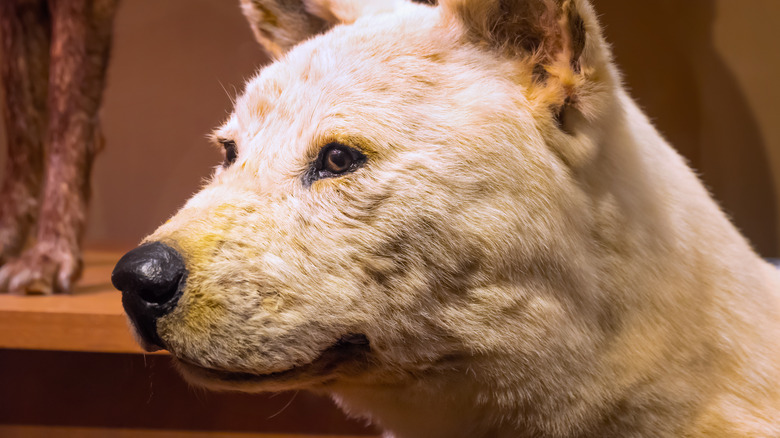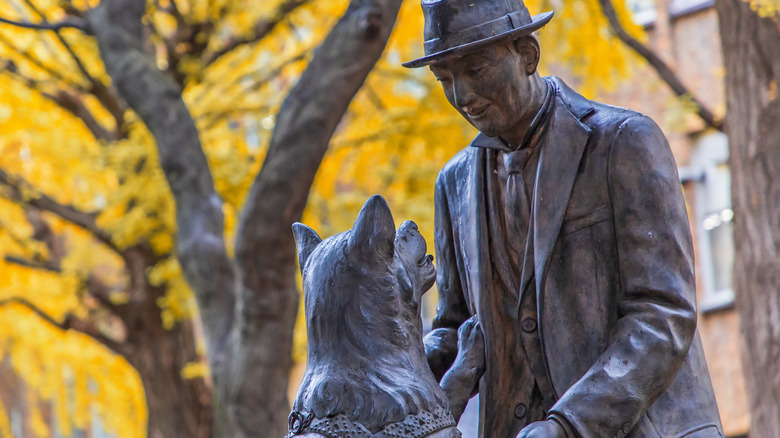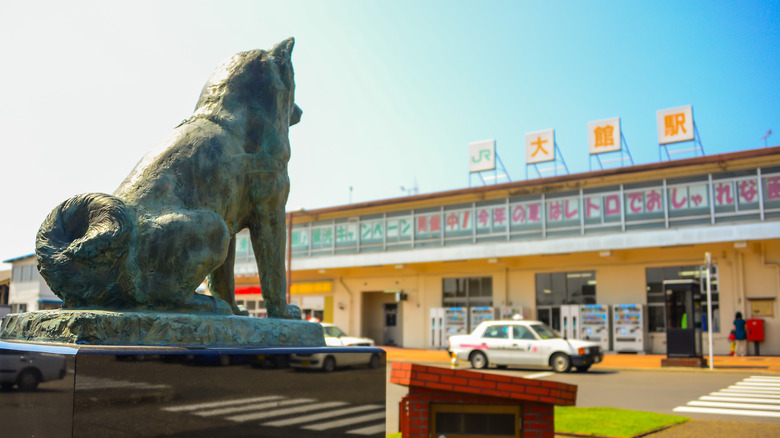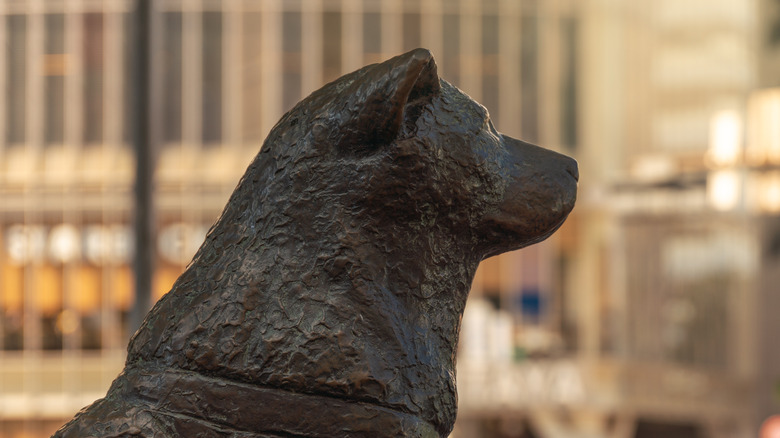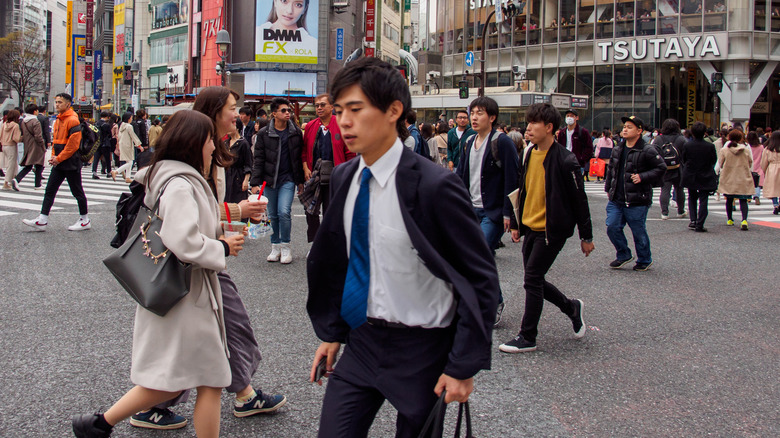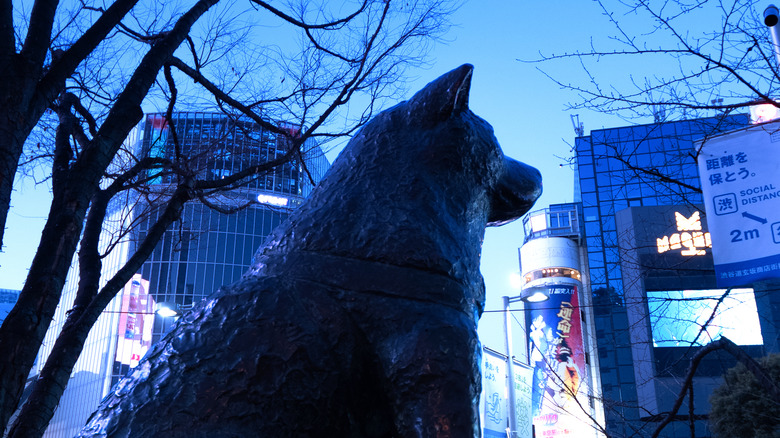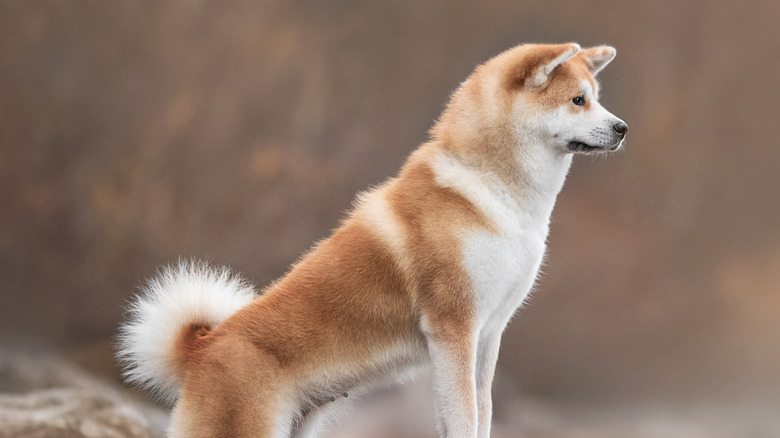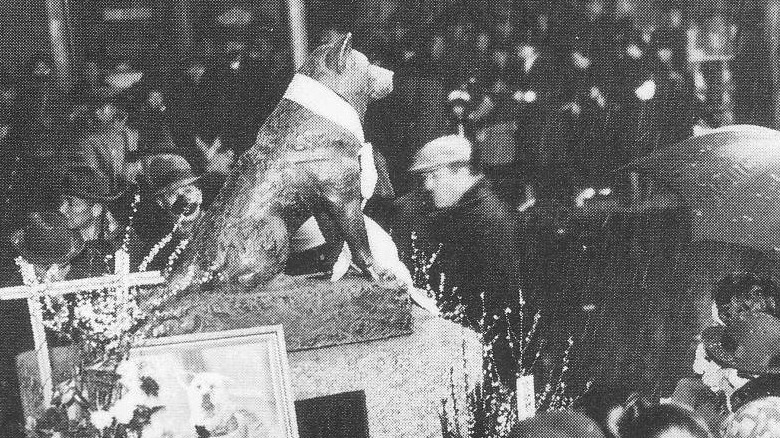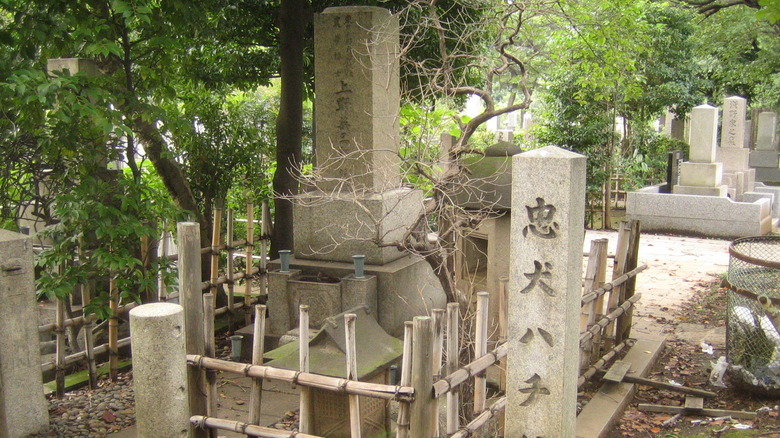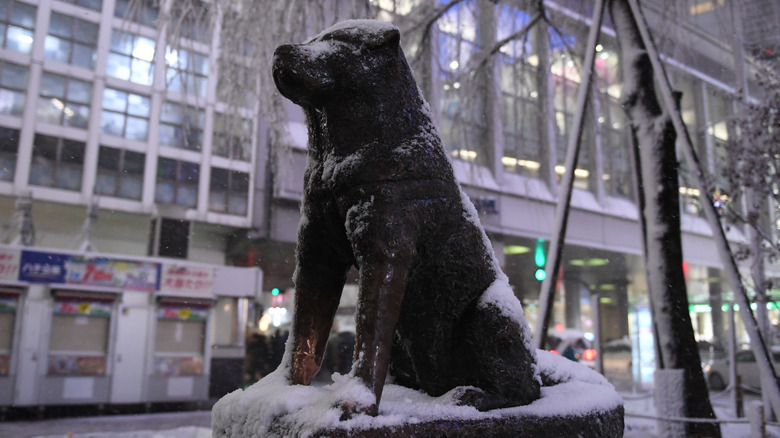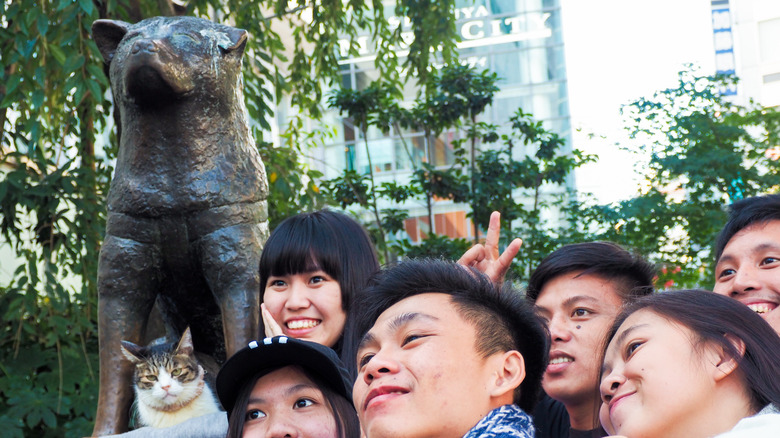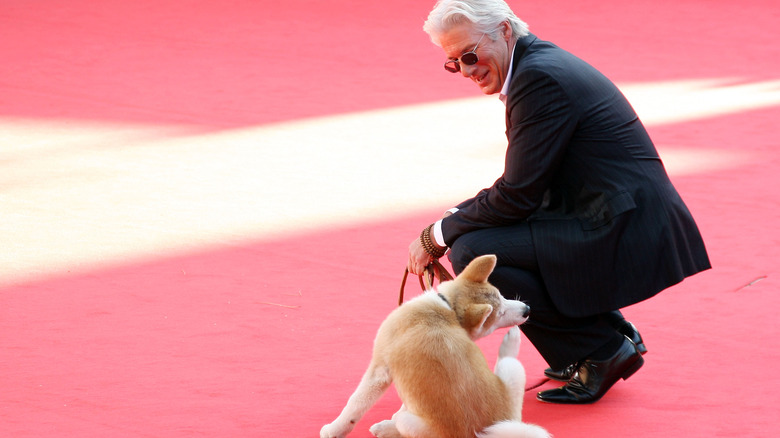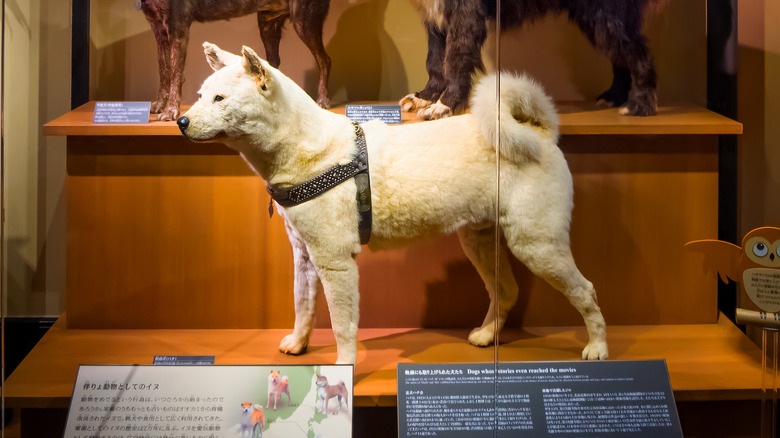The True Story Of The World's Most Loyal Dog, Hachiko
Bring up the subject of faithfulness in any discussion, and there's a good chance that the first thing that comes to everyone's mind is the near-legendary loyalty of man's best friend. Over the centuries, dogs have had a reputation for being tremendously loyal to their masters — and interestingly enough, there's scientific evidence that may back up this assertion.
In a 2005 experiment cited by Purina, dogs' brains — specifically, the parts that are "associated with enjoyment and positive emotions" — reportedly lit up in scans after they got a whiff of their owners' distinct scents. This evidence points to canine companions' ability to recognize their owners, supposedly exhibiting what would normally be considered "love" for human beings. Then again, considering how dogs took a different turn on the evolutionary tree from wolves after socializing and bonding with humans across millennia (via National Geographic), this isn't entirely surprising.
That said, when it comes to loyal dogs, one name stands out among all others: Hachiko, the white Akita who faithfully awaited the return of his dead master at a Japanese train station every day for almost 10 years. Here is the tragic yet heartwarming true story of the pup recognized by many as the most loyal dog in the world.
When Hachiko met his owner
The tale of the famously faithful Hachiko began on November 10, 1923. The Japan Times cites "Collection of Hachiko's Materials," a compilation of information about the dog that is said to be "the most detailed record" of his life, and states that his birthplace was a farm in Odate City, in the Akita Prefecture. According to Time Out Tokyo, Hachiko's father was named Oshinai (after their place of residence), while his mother was named Goma (Japanese for "sesame").
About two months after Hachiko was born, a professor and agricultural scientist at Tokyo Imperial University (now the University of Tokyo) named Hidesaburo Ueno acquired the young Akita-inu. While the Japan Times says that Hachiko was "given" to the professor, Time Out Tokyo claims that Ueno actually bought Hachiko for the then-princely sum of 30 yen, as he was actually in search of a pure-bred Akita. Either way, Ueno and his new companion made their way from Hachiko's birthplace to the professor's residence in Shibuya Ward, Tokyo.
Interestingly, per Time Out Tokyo, Hachiko's original name was just Hachi. Ueno reportedly based his name on the number eight, due to its association with fortune and good luck in Japanese culture.
Waiting at the train station every day
Despite being whisked away from his parents and essentially forced to live in an unfamiliar environment, it didn't take long for the young Akita-inu pup to become well-acquainted with his new master's life in Tokyo.
As Hidesaburo Ueno held a teaching position at his university's agricultural department, he had to travel to the university every day via train (per The Japan Times). Specifically, Ueno would walk to the railway station in Shibuya. After Hachi came into his care, Ueno started bringing the pup along with him as he traveled to the station. There, he would board the train to work, leaving Hachi behind. At the end of the day, the loyal dog would reappear at Shibuya Station, waiting patiently for his master to alight from the train. Over time, this became the pair's routine (via Digital Journal).
Ueno and Hachi's daily trips to the train station went on for a little over a year. Sadly, the pair's everyday habit came to a tragic end on May 21, 1925, after Ueno died mid-lecture due to a cerebral hemorrhage (via Atlas Obscura).
An almost decade-long wait
As Hidesaburo Ueno died while working, Hachi had no way of realizing that his master's life had already ended and that it would no longer need to greet Ueno at Shibuya Station.
According to The Japan Times, since his master was no longer around to care for him, Hachi was given a new home in the Asakusa district. However, it seemed like his love and longing for his master were just too strong, as he would often escape his new house and travel all the way back to Ueno's Shibuya residence. It reached the point where Hachi was eventually placed in the care of a Shibuya-based breeder. (Time Out Tokyo offers a slightly different story, saying that it was Ueno's former gardener Kikuzaburo Kobayashi who eventually became Hachi's caretaker.)
This also meant that the loyal dog could resume the daily routine he once shared with Ueno — and so, even though there was no longer any reason for Hachi to be there, he continued to show up at the station every day to welcome his master home. This remarkable habit of Hachi's lasted for nearly a decade until his death (per Berfrois).
How people initially reacted to Hachiko
Even after Hidesaburo Ueno died and Hachi was transferred to a different household, the dog kept stubbornly returning to the very spot in front of Shibuya Station where he would meet his master after a day's work (via Time Out Tokyo). By the time the Akita-inu pup was transferred to the care of someone living in Tomigaya (a district that was quite close to the station), Hachi's trips to Shibuya Station became a regular occurrence. This made it a common sight for the people at the station. Unfortunately, even though his unending loyalty eventually gained Hachi much respect and admiration, this wasn't the case initially.
Per Time Out Tokyo, there were quite a few anecdotes about the loyal dog being "beaten and bullied by pedestrians and even children while he lingered around the station." That said, the situation wasn't totally bad for Hachi, at least according to the Digital Journal. Apparently (and thankfully), not everyone at the station felt that harassing Hachi was a worthwhile pastime. Some people didn't think much of the pup, assuming that he was merely hanging out there for no good reason. However, when they realized that Hachiko was actually waiting for someone who would never arrive, they became sympathetic to the dog, feeding him and giving him water. While some theorized that Hachiko only showed up there to beg for food, the fact that he arrived at the exact time Ueno's train used to arrive debunks this theory.
Hachiko's rise to stardom
For the next seven years after Hidesaburo Ueno's passing, Hachi continued to show up at Shibuya Station in the vain hope of seeing his master again. It's likely that Hachiko would have simply continued to be a generally unremarkable (albeit regular) sight at the station if it hadn't been for someone who took notice of his unique habit and published a story that almost instantly made the faithful Akita-inu famous.
After Nihon Ken Hozonkai ("The Association for the Preservation of the Japanese Dog") chairman Hirokichi Saito learned about Hachi and his predicament, he published an article in one of Japan's largest newspapers, Asahi Shimbun, featuring the pup's story (per Time Out Tokyo). According to The Japan Times, the piece (which was published in October 1932) bore the headline, "Story of a beloved old dog. Several years eagerly awaiting the return of his now-deceased master." The article became the catalyst for Hachi gaining massive attention from readers, who admired his loyalty to his master. This also led to them adding the "ko" suffix at the end of Hachi's name as an honorific of sorts (via Time Out Tokyo). Two years later, local officials erected a life-sized monument to Hachiko just outside Shibuya Station, per Berfrois.
On an interesting note, various sources like the Digital Journal identified Saito as a former student of Ueno's who figured out why Hachi frequented Shibuya Station by observing the dog's behavior and taking note of when he would show up.
Hachiko: a rare purebred Akita
Interestingly, the newspaper article that skyrocketed Hachiko's fame came at a time when Japan had just started to hold its indigenous dog breeds in higher regard (via Berfrois). Because of Western influence, native breeds were initially perceived as "vicious and cowardly creatures," which doomed many of them to extinction. However, when Japan grew its own power and influence in the early 1900s, its perception about indigenous breeds — including the Akita — sharply changed.
The American Kennel Club describes the Akita breed as "burly, heavy-boned spitz-type dogs of imposing stature" produced by generations of selective breeding. Despite nearly going extinct a few times over the course of Japanese history, the Akita managed to bounce back, in large part due to the government and concerned citizens' attempts to preserve it and other endangered breeds.
For many dog researchers, Hachiko served as "a good representative of the Akita dog of his day" (via the Akita Learning Center). Thus, with the loyal Akita dog's popularity surge came increased awareness about his breed as well.
The death of Hachiko
For three years after the publication of the article that made him a national sensation, Hachiko continued to show up at Shibuya Station every day to wait for his master. As it turned out, only death could put an end to the loyal Akita-inu's quest.
Hachiko breathed his last breath on March 8, 1935 (via Australian Dog Lover Magazine). The faithful pup's body was discovered on a street in Shibuya, and for a time, people weren't completely sure what caused his death. Some speculated that it was a yakitori skewer that caused a fatal stomach injury (per The Japan Times). However, research conducted decades later debunked this idea. In 2011, veterinarians at the University of Tokyo were able to solve the mystery of Hachiko's death after examining his internal organs. While they did find four yakitori sticks in his stomach, veterinarian Kazuyuki Uchida confirmed that they didn't cause the dog's death. Instead, Hachiko actually died because he was infected with filarial worms. Furthermore, he also had terminal cancer.
If it's any comfort, the findings suggest that Hachiko was well-fed and properly cared for until his death. As animal anatomy specialist Hideki Endo explained via The Japan Times, "Hachiko lived a better life in Shibuya with good care from people in the restaurant area. Finding red lanterns, he went there and satisfied his appetite with grilled chicken he was given."
The reunion of Hachiko's family
In the end, it was Hachiko's passing that would ultimately serve as the catalyst for his reunion with his beloved master (via Japan Travel). When the loyal Akita-inu died, his remains were taxidermied, but the rest of him was cremated. His ashes were buried next to Hidesaburo Ueno in Aoyama Cemetery in Tokyo. As Time Out Tokyo explains, the park-like cemetery also has a shrine to Hachiko next to Ueno's tomb.
Over four decades after Hachiko's death, he and his master were reunited with his other keeper, Yaeko Sakano. A 2016 article in The Mainichi talks about how, despite being a longtime partner and wife to Ueno, she did not take the professor's family name. When she died in 1961, her remains were not buried with Ueno's; instead, they were laid to rest at a temple at the Taito Ward in Tokyo. However, in 2014, a professor at the University of Tokyo named Sho Shiozawa stumbled upon Yaeko's final wish to be buried with her husband. As a result, Shiozawa moved to honor Yaeko's last request by asking for her family's permission to move her remains.
Shiozawa believes that this was a significant milestone in the story of Hachiko. "By putting the names of both (Hidesaburo and Yaeko) on their grave, we can show future generations the fact that Hachiko had two keepers," he told The Mainichi.
Monuments honoring Hachiko
Hachiko became so beloved by the people who knew his story that even while he was still alive, people started immortalizing him.
Per The Japan Times, sculptor Teru Ando erected a statue of the loyal Akita-inu in April 1934. However, the dog's statue was melted down a decade later due to the Japanese government's urgent need for metals during the war effort (the metals obtained from Ando's masterpiece became part of a locomotive). On August 15, 1948, a replacement statue was unveiled in celebration of the end of the war. Interestingly, it was sculpted by Teru's son, Takeshi. Over time, parts of the statue became discolored due to the sheer number of people attempting to touch the monument. "It is proof that he is loved and touched by everybody," Takeshi said. Just opposite the statue is a mural called the "Hachiko Family Mural," which features "a bit of canine company for the faithful dog" sculpted by artist Ryutaro Kitahara (via Japan Travel).
More recently, in 2015, the University of Tokyo came up with its own idea for a statue that honored not just Hachiko but professor Hidesaburo Ueno as well (per Time Out Tokyo). The statue features the master and his companion finally reuniting after so many years. It was completed with the help of approximately 10 million yen's worth of donation and is now located within the boundaries of the university.
An annual holiday for Hachiko
At the spot near Shibuya Scramble Square where Hachiko used to wait faithfully for Hidesaburo Ueno to come home, those who love the dog and his story of undying loyalty gather around at least once a year to celebrate his life and memory (per Time Out Tokyo). Called the Chuuken Hachiko Matsuri, it is celebrated every April 8, which is one month after Hachiko's death anniversary (per Japan Travel). On this day, people decorate Hachiko's spot with flowers, and a small, solemn ceremony is held to honor the faithful dog (via YouTube).
That said, Hachiko and his statue only get attention once a year. In fact, for most of the year, people from different locations travel to this iconic location not just to see the statue of Hachiko for themselves but also to admire the beauty of the place. According to Japan Travel, an estimated 2.4 million people pass by Hachiko's bronze statue daily as they make their way to Shibuya Station.
Hachiko in popular culture
Aside from being immortalized as various statues, Hachiko has also been a steadfast part of literature, films, and other forms of popular culture.
A couple of years after the beginning of Hachiko's rising popularity, government officials in charge of education decided that his story was important enough to be included in one of their primary school textbooks (per Berfrois). Specifically, it was a textbook for 2nd-graders tackling subjects of morality, and it bore the title "Never forget moral indebtedness," according to The Japan Times. Possibly because of Hachiko's popularity and the lessons that come from his story, the book that featured him "became required reading for students throughout the Japanese empire," as Berfrois explains. In 2004, a children's book titled "Hachiko: The True Story of a Loyal Dog" was published.
Meanwhile, Hachiko was featured on the silver screen in at least two retellings of his life. First was "Hachiko Monogatari," a film that premiered in 1987. Over two decades later, the Hollywood movie "Hachi: A Dog's Tale" came out, which starred famous Hollywood actor Richard Gere as Ueno's fictional counterpart.
Where is Hachiko now?
While Hachiko's ashes are buried with his owner, there's still plenty of him to see if you want to get to know the loyal dog up close. According to The Japan Times, the taxidermied remains of Hachiko are on display located at the National Museum of Nature and Science, located at Taito Ward's Ueno Park.
Hachiko has his own spot in the museum — positioned at a relatively low height so that museum visitors are encouraged to kneel exactly like how they would to pat their pets — and is flanked by two other notable dogs in Japanese history (per Atlas Obscura). One of them is Jiro, a Sakhalin Husky whose claim to fame was being able to survive the harsh conditions in Antarctica, despite being practically abandoned there for about a year. The other is Kai Ken, and the specimen falls under an extremely rare breed that Atlas Obscura calls "the most ancient and purest dog breed in Japan."
